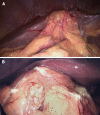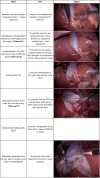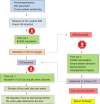Safe laparoscopic cholecystectomy: Adoption of universal culture of safety in cholecystectomy
- PMID: 30842813
- PMCID: PMC6397793
- DOI: 10.4240/wjgs.v11.i2.62
Safe laparoscopic cholecystectomy: Adoption of universal culture of safety in cholecystectomy
Abstract
The incidence of biliary injury after laparoscopic cholecystectomy (LC) has shown a declining trend though it may still be twice that as with open cholecystectomy. Major biliary or vasculobiliary injury is associated with significant morbidity. As prevention is the best strategy, the concept of a culture of safe cholecystectomy has been recently introduced to educate surgeons and apprise them of basic tenets of safe performance of LC. Various aspects of safe cholecystectomy include: (1) thorough knowledge of relevant anatomy, various anatomical landmarks, and anatomical variations; (2) an understanding of the mechanisms involved in biliary/vascular injury, the most important being the misidentification injury; (3) identification of various preoperative and intraoperative predictors of difficult cholecystectomy; (4) proper gallbladder retraction; (5) safe use of various energy devices; (6) understanding the critical view of safety, including its doublet view and documentation; (7) awareness of various error traps (e.g., fundus first technique); (8) use of various bailout strategies (e.g., subtotal cholecystectomy) in difficult gallbladder cases; (9) use of intraoperative imaging techniques (e.g., intraoperative cholangiogram) to ascertain correct anatomy; and (10) understanding the concept of time-out. Surgeons should be facile with these aspects of this culture of safety in cholecystectomy in an attempt to reduce the incidence of biliary/vascular injury during LC.
Keywords: Bile duct injury; Bile leak; Cholecystectomy; Cholecystitis; Cholelithiasis.
Conflict of interest statement
Conflict-of-interest statement: There is no conflict of interest associated with any of authors contributed their efforts in this manuscript.
Figures















References
-
- Gupta V. ABCD of Safe Laparoscopic Cholecystectomy: Imbibing Universal Culture of Safety in Cholecystectomy. Indian J Surg. 2018
-
- Berci G, Hunter J, Morgenstern L, Arregui M, Brunt M, Carroll B, Edye M, Fermelia D, Ferzli G, Greene F, Petelin J, Phillips E, Ponsky J, Sax H, Schwaitzberg S, Soper N, Swanstrom L, Traverso W. Laparoscopic cholecystectomy: first, do no harm; second, take care of bile duct stones. Surg Endosc. 2013;27:1051–1054. - PubMed
-
- Fédération de chirurgie viscérale et digestive. Risk management to decrease bile duct injury associated with cholecystectomy: measures to improve patient safety. J Visc Surg. 2014;151:241–244. - PubMed
-
- Barrett M, Asbun HJ, Chien HL, Brunt LM, Telem DA. Bile duct injury and morbidity following cholecystectomy: a need for improvement. Surg Endosc. 2018;32:1683–1688. - PubMed
-
- Pucher PH, Brunt LM, Davies N, Linsk A, Munshi A, Rodriguez HA, Fingerhut A, Fanelli RD, Asbun H, Aggarwal R SAGES Safe Cholecystectomy Task Force. Outcome trends and safety measures after 30 years of laparoscopic cholecystectomy: a systematic review and pooled data analysis. Surg Endosc. 2018;32:2175–2183. - PMC - PubMed
Publication types
LinkOut - more resources
Full Text Sources
Other Literature Sources
Medical
Research Materials

